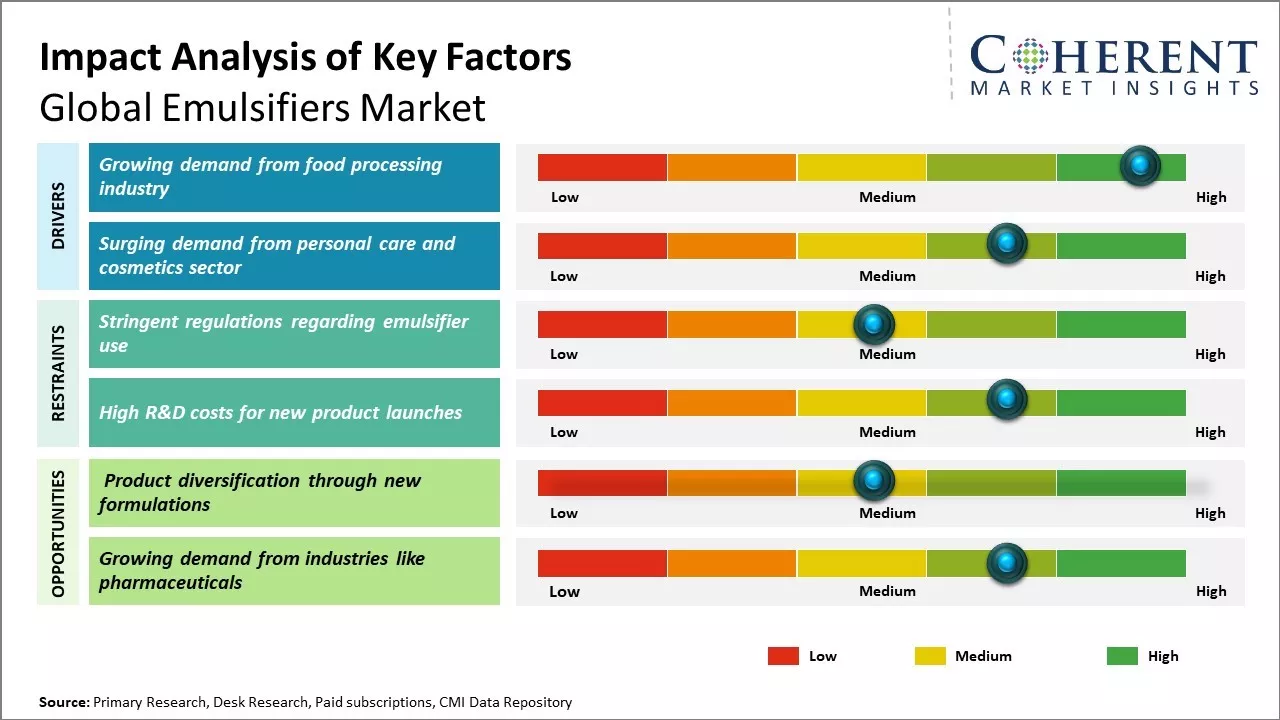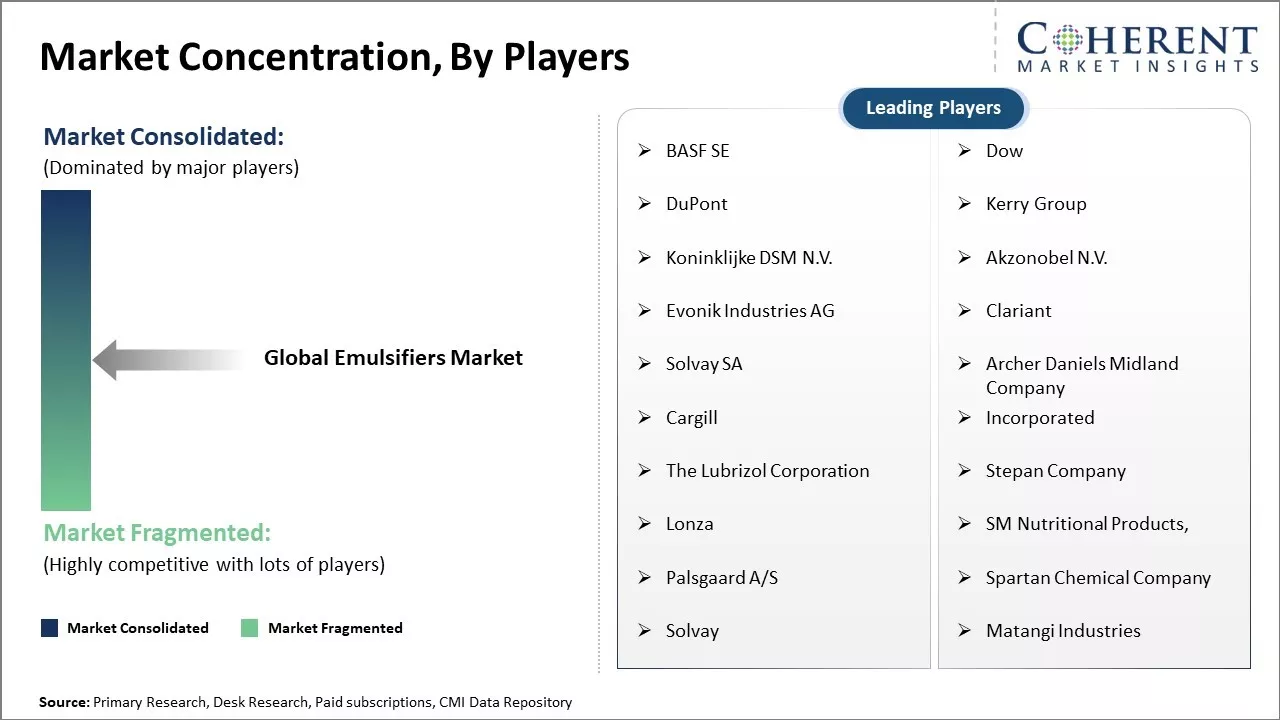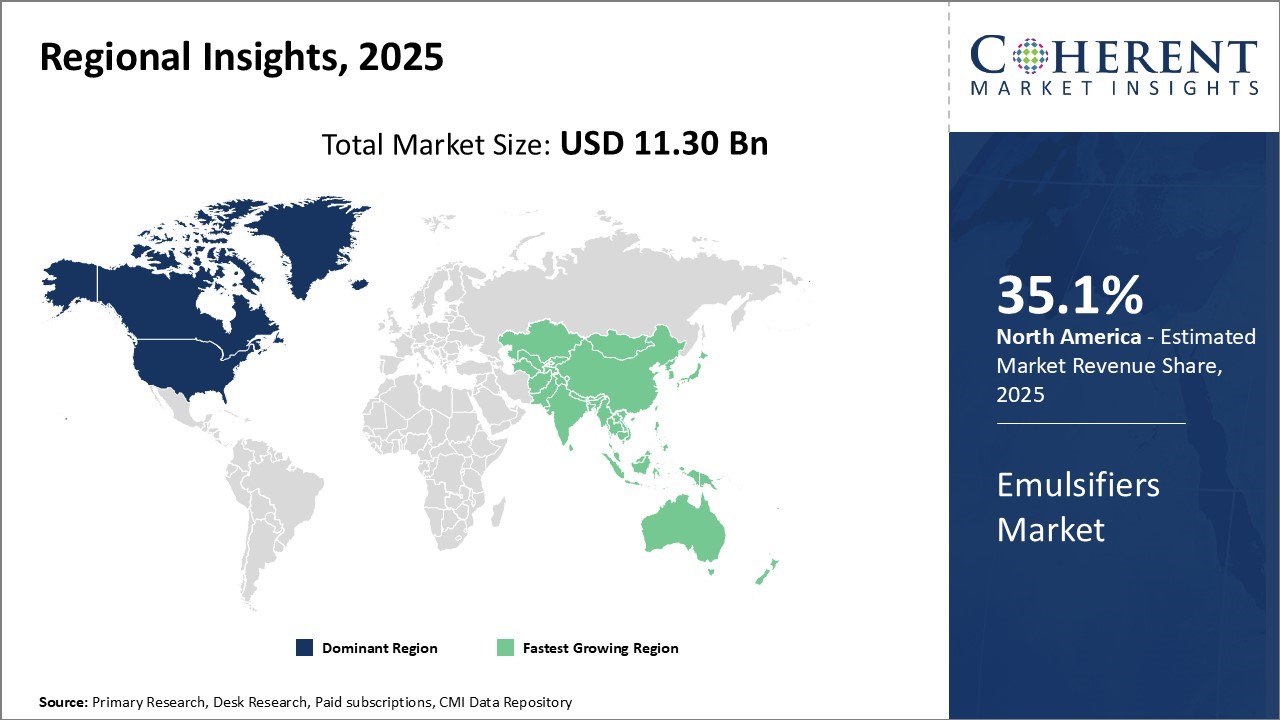The emulsifiers market is estimated to be valued at USD 11.30 Bn in 2025 and is expected to reach USD 18.88 Bn by 2032, exhibiting a compound annual growth rate (CAGR) of 7.6% from 2025 to 2032.

To learn more about this report, Download Free Sample
The increasing demand from various industries like the food processing industry is expected to drive the market growth. Emulsifiers help to extend the shelf life of products and maintain quality and texture during processing and distribution activities in the food and beverage industry. Growth in the convenience food industry and rising consumption of packaged food are also contributing to the increased demand for emulsifiers. Moreover, rising disposable income and changing lifestyles leading to more prosperity is further expected to propel the market growth during this period. Wide applications in various end-use industries along with innovation of bio-based emulsifiers are expected to provide growth opportunities in the coming years.
|
Event |
Description and Impact |
|
Regulatory Shifts Toward Sustainability |
|
|
Commodity Market Volatility |
|
|
Technological and Industrial Advancements |
|
Uncover macros and micros vetted on 75+ parameters: Get instant access to report
- Industrial Grade: $3.50-5.20/kg
- Food Grade: $6.80-9.40/kg
- Pharmaceutical Grade: $12.50-18.70/kg
- Cargill Lecithin: $7.20-15.60/kg (food-grade varieties)
- ADM Natural Origin: $8.90-17.30/kg (specialized applications)
- Lipoid: $25.40-45.80/kg (pharmaceutical-grade)
- Organic Food Grade: $18.90-24.70/kg
- Non-GMO Premium: $15.20-19.80/kg
- Standard Food Grade: $11.30-14.60/kg

To learn more about this report, Download Free Sample
The global food processing industry has been witnessing strong growth over the past few years. Rapid urbanization, rising disposable incomes, and changing lifestyles have led to a surge in the demand for packaged, processed, and convenience foods worldwide. Emulsifiers play a vital role in the production of various packaged food products.
They help improve texture, increase shelf life by preventing separation of ingredients, and enhance sensory properties. The bread industry extensively uses emulsifiers to improve loaf volume and structure. Mayonnaise, salad dressings, ice creams, and other dairy products also require specific types of emulsifiers for uniform mixing and stabilization.
Amid rising health awareness, the adoption of low-fat and low-calorie food options has sharply increased. To produce reduced-fat foods with ideal attributes like texture and mouth feel, emulsifiers are important. They help incorporate a water phase into oil-saturated mixtures which helps decrease fat content.
Emulsifier makers are actively pursuing new product development which meets multifunctional requirements for low-fat and nutritionally improved foods. Increasing bakery, dairy, and packaged snack companies in developing regions are expected to increase usage of emulsifiers in coming years. The international food safety regulations mandate the use of certified emulsifier additives increasing its commercial utilization worldwide.
The emulsifiers are gaining importance in hair care, skincare, color cosmetics, and perfumes due to the exceptional personal care and cosmetic products emulsifiers have brought. Emulsifiers are incredibly useful with formulations with oil and water as they blend them smoothly, preserving balance and texture while keeping them stable. They assist in maintaining a uniform distribution of color pigments, vitamins, and other actives in lotions, creams and topical products.
Due to rapid urbanization along with particular focus towards self-grooming has led to constructed spending power on beauty items globally. Because of which, an increase is observed for emulsifier reagents since these are used widely which found application in the foundations as well as other dermatological sunscreens, shampoos hair conditioners and serums.
Product diversification through new formulations is a major opportunity in the emulsifiers market that can significantly impact its long-term growth trajectory. As consumer food preferences become more diverse and demand for specialized products increases, emulsifiers that can enable novel textures, enhanced nutrition, and unique tastes/flavors will be in high demand.
Manufacturers are actively exploring new formulation technologies to develop high-performing emulsifiers tailored for plant-based alternatives, non-dairy products, clean-label items, and fortified/functional foods.
In terms of source, the synthetic segment is expected to contribute 76.2% share of the global emulsifiers market in 2025, owing to its low cost of production and versatility. Synthetic emulsifiers can be customized during manufacturing to meet the specific technical requirements of various end-use applications. They offer superb stability and workability across a wide range of pH levels and temperatures. This increases their usage in diverse industrial sectors like food processing, personal care, and pharmaceuticals.
Synthetic emulsifiers are derived from petroleum-based feedstocks through chemical synthesis, allowing for mass production. This economies of scale enable synthetic varieties to undercut bio-based options in terms of price. Their affordable costs make synthetic emulsifiers attractive for use in mass-consumed, low-budget food and homecare products. Demand for value-for-money items among cost-conscious consumers, especially in emerging economies, further drives adoption.
Synthetic emulsifiers also demonstrate excellent shelf-life extension and preservation abilities. This amplifies their function in processed snacks, desserts, and ready meals that require a long shelf life without compromises to texture or quality. Detailed customization at the molecular level yields emulsifiers that impart unique sensory properties desirable to product developers and formulators.
While bio-based options gain traction owing to clean label trends, synthetic emulsifiers will continue dominating on the strength of their stable performance, affordability, and personalized characteristics supporting innovative product launches. Mass manufacturing capabilities and functional superiority especially in shelf-stable packaged food and low-cost personal care segments will propel the synthetic variety to remain a market leader.
The food & beverage industry is expected to account for 42% share of the global emulsifiers market in 2025 attributable to their ubiquitous need across many product categories. Emulsifiers play vital roles in improving texture, stability, and sensory qualities of processed foods and drinks. They enable the creation of emulsions which help incorporate oils, fats, and liquids into solid or semi-solid food matrices.
In culinary applications, emulsifiers permit ingredient blending and combination that would otherwise separate. They allow oil-in-water or water-in-oil emulsions integral to many staple foods. Mayo, salad dressings, baked goods, processed meats, snack foods extensively use emulsifiers to achieve desired mouthfeel and prolonged shelf life. In beverages, emulsifiers provide stability against separation in oil-containing products like coconut milk, coffee creamers, flavored drinks. They prevent curdling and sedimentation that can lead to an unsightly product and consumer dissatisfaction.
As lifestyles get busier with more demand for convenient, prepared options, food manufacturers incorporate ever complex formulations with emulsifiers to satisfy this need. Their functionality supports innovations from reduced/low-fat to high-protein/fiber variants across many product lines. An aging population also drives demand for emulsifier-enabled easy-to-swallow, nutrient-fortified options.

To learn more about this report, Download Free Sample
North America is anticipated to dominate the global emulsifiers market with an estimated 35.1% share in 2025, driven by its robust food processing industry and strong regional presence of leading emulsifier producers. Major food companies are located in the United States and Canada, where they continuously innovate to meet customer needs, creating high demand for emulsifiers for new products. The international and regional supply chains are also optimized with multinationals like Archer Daniels Midland (ADM) and Cargill that have large production and distribution networks as well as sophisticated oilseed processing plants.
Also important are the FDA-approved food-grade emulsifiers that need to be used under strict safety regulations, which also boosts compliance and quality control. North America is also advantaged by NAFTA-like trade deals which further improves export potential. Further market consolidation strengthens North America’s position as a key source for global distribution of emulsifiers while providing advanced services in their manufacturing and application development.
Asia Pacific is emerging as the fastest-growing market for emulsifiers, fueled by changing consumer lifestyles, rising disposable incomes, and a marked shift toward packaged and convenience foods in countries like India and China. The changing lifestyles and growing middle-class population have resulted in higher consumption of processed foods. As a result, there is a need for stabilizing agents like emulsifiers which are used to improve the texture and shelf life of products.
The growth of international food companies through joint ventures and local manufacturing has aided in technology transfer and innovation among local processors. These partnerships allow SMEs to enhance product quality and extend shelf-life using emulsifier technologies.
Additionally, better infrastructure and global sourcing provide the region with affordable raw materials, reinforcing regional growth. Beyond food, Asia’s youth demographic is driving demand in personal care, cosmetics, and other non-food industries which use emulsifiers increasing the scope of applications. With strong demographics coupled with rising investments makes the region an opportunity to focus on for strategists as it becomes a critical growth engine alongside changing preferences for growth.
The United States leads the North American emulsifiers market, underpinned by a mature food processing ecosystem, consistent product innovation, and strong regulatory oversight. The presence of industry leaders such as ADM and Cargill enhances the country’s global competitiveness through scale, efficiency, and expertise in oilseed-derived emulsifier production. Demand is further supported by a diverse range of applications spanning processed foods, beverages, and personal care products.
China plays a central role in the rapid expansion of the Asia Pacific emulsifiers market. Rising consumer preference for packaged and ready-to-eat meals, coupled with an expanding middle class and modernization of the food industry, drives emulsifier utilization. Strategic collaborations with global firms and growing domestic production capacity are accelerating innovation and quality improvements. China's evolving regulatory landscape and improved raw material availability also enhance the region’s attractiveness for investment and long-term growth.
| Report Coverage | Details | ||
|---|---|---|---|
| Base Year: | 2024 | Market Size in 2025: | USD 11.30 Bn |
| Historical Data for: | 2020 To 2024 | Forecast Period: | 2025 To 2032 |
| Forecast Period 2025 to 2032 CAGR: | 7.6% | 2032 Value Projection: | USD 18.88 Bn |
| Geographies covered: |
|
||
| Segments covered: |
|
||
| Companies covered: |
BASF SE, Dow, DuPont, Kerry Group , Koninklijke DSM N.V. , Akzonobel N.V., Evonik Industries AG, Clariant , Solvay SA , Archer Daniels Midland Company , Cargill, Incorporated, The Lubrizol Corporation , Stepan Company , Lonza, SM Nutritional Products, Palsgaard A/S, Spartan Chemical Company, Solvay, and Matangi Industries |
||
| Growth Drivers: |
|
||
| Restraints & Challenges: |
|
||
Uncover macros and micros vetted on 75+ parameters: Get instant access to report
Share
Share
About Author
Yash Doshi is a Senior Management Consultant. He has 12+ years of experience in conducting research and handling consulting projects across verticals in APAC, EMEA, and the Americas.
He brings strong acumen in helping chemical companies navigate complex challenges and identify growth opportunities. He has deep expertise across the chemicals value chain, including commodity, specialty and fine chemicals, plastics and polymers, and petrochemicals. Yash is a sought-after speaker at industry conferences and contributes to various publications on topics related commodity, specialty and fine chemicals, plastics and polymers, and petrochemicals.
Missing comfort of reading report in your local language? Find your preferred language :
Transform your Strategy with Exclusive Trending Reports :
Frequently Asked Questions
Joining thousands of companies around the world committed to making the Excellent Business Solutions.
View All Our Clients